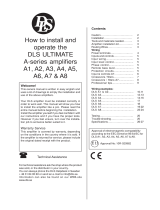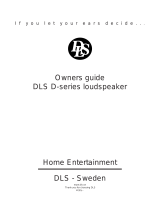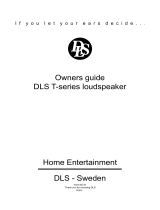
Low level input
Use a pair of shielded stereo audio cables with RCA
type jack. Most trunk-mount amplifiers need a 20
feet RCA cable ( appr 5 – 6
meters). Most under the seat
installations require 12 feet (
2 – 3 meters) RCA cables.
Avoid placing the RCA cable
close to speaker cables,
power cables and remote
control cable. Connect to in-
put socket A & B.
Input and controls
Input Wiring
Inputs may be low level from the RCA output of the
car stereo.If your head unit has a separate RCA sub
output we recommend that you to use it for connection
with the CA10
5
CA10
Level
2V 0,7V
5V 0,25V
Input Level control
The input level control, 5V – 0,25 V,
matches the output of your radio to
the input of the amplifier. After instal-
lation is complete, make sure the in-
put of the amplifier is turned down all
the way ( counter-clockwise at 5V ).
Play a tape or CD, make sure all bass
or treble settings or equalizer are flat, and turn the
volume of the radio up until you just start to hear
distortion. Turn the volume control down just a bit.
On the amplifier increase the input level control (
clockwise or to the right ) until you just start to hear
distortion, then back the level control just a bit. Now
your radio and amplifier levels are matched.
Subsonic filter
The Subsonic filter blocks
the
very deepest frequencies from
reaching the subwoofers. It has a
fixed frequency of 25 Hz and can
be switched On / Off.
Bass Boost on CA10
Bass Boost is used to
increase the bass
volume. You can select
the amplification
between 0 dB
( no amplification ) and
18 dB ( full amplification ).
This function is used to compensate for the bass
box function and to adjust for your own taste of
bass. Set level control at 0 dB if you want it to be
inoperative.
The Bass Boost level can also be adjusted from
the front seat by using the remote level control
box. Connect the cable coming with the amplifier
between the control box and Bass Boost connector
on the amplifier.
Low Pass Filter
The LPF ( low pass filter ) allow
low frequencies only and blocks
higher frequencies.
A typical setting is 60 – 80 Hz.
Choose the setting that sounds
best in your car.
LPF
40Hz 125Hz
Power
(Green)
Protect
(Red)
Power Light / Protect light
The power light (green ) comes on when
the amplifier is turned on.
The protect light ( red ) comes on
when the amplifier shuts down from
overheating, or a short circuit ( spea-
ker failure)
Bass Boost
6dB 12dB
0dB 18dB
Subsonic
Off On
Phase control
The phase control can be set
continuously from 0 - 180
degrees. This is very useful when
you want to adjust the bass
sound for best front stage image.
Start on 0 and turn the control
slowly clockwise until you
experience the bass sound
coming from the front.
It is also useful when you have
more than one CA10 and want
all speakers to play in phase.
You may have to change the
polarity of the speaker
connection to get the best result.
PHASE
0 180












